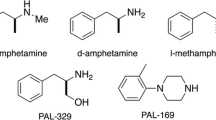Abstract
Rationale: The discriminative-stimulus effects of cocaine have been reported to be mediated by indirect agonist actions initiated by the blockade of dopamine uptake, and the potencies of drugs that have discriminative-stimulus effects like cocaine are directly related to their dopamine transporter binding affinities. The binding to the dopamine transporter by cocaine and many of its analogs has been reported to fit better using a two-site model than a one-site model. Objectives: The present study examined the relationship among binding affinities of dopamine uptake inhibitors at these two sites and their potencies to produce discriminative-stimulus effects. Methods: The inhibition constants (K i values) were derived for unlabeled dopamine uptake inhibitors for displacement of [3H]WIN 35,428 from rat caudate putamen membranes. These K i values were related to the ED50 values obtained in rats trained to discriminate 10 mg/kg cocaine from saline injections under a fixed-ratio 20 schedule of food reinforcement. Results: Among the dopamine uptake inhibitors studied, the binding data for eight compounds (WIN 35,428, nomifensine, WIN 35,981, WIN 35,065-2, methylphenidate, cocaine, cocaethylene, and bupropion) were better fit by a two-site model than a one-site model. The data for the remaining eleven compounds (RTI-31, RTI-55, RTI-121, RTI-32, LU19-005, BTCP, GBR12909, GBR12935, mazindol, LU17-133, and EXP561) were better fit by a one-site model. Of the drugs that were fit best by a two-site model, there was a higher correlation among the K i values for the high-affinity site and the ED50 values (R2=0.655; P=0.015) than there was for the low-affinity site (R2=0.543; P=0.037). Of the remaining drugs, there was a high correlation among the K i values and the ED50 values for the discriminative-stimulus effects (R2=0.523; P=0.012). Conclusions: These data suggest that the discriminative-stimulus effects of cocaine are more closely related to actions mediated by high-affinity binding to the dopamine transporter than they are to actions mediated by the low-affinity site. The further assessment of the respective contributions of high- and low-affinity binding to the behavioral effects of cocaine will be greatly enhanced with the development of pharmacological tools that have a high degree of selectivity for one of these components.
Similar content being viewed by others
Author information
Authors and Affiliations
Additional information
Received: 24 May 1999 / Final version: 30 July 1999
Rights and permissions
About this article
Cite this article
Katz, J., Izenwasser, S. & Terry, P. Relationships among dopamine transporter affinities and cocaine-like discriminative-stimulus effects. Psychopharmacology 148, 90–98 (2000). https://doi.org/10.1007/s002130050029
Issue Date:
DOI: https://doi.org/10.1007/s002130050029




